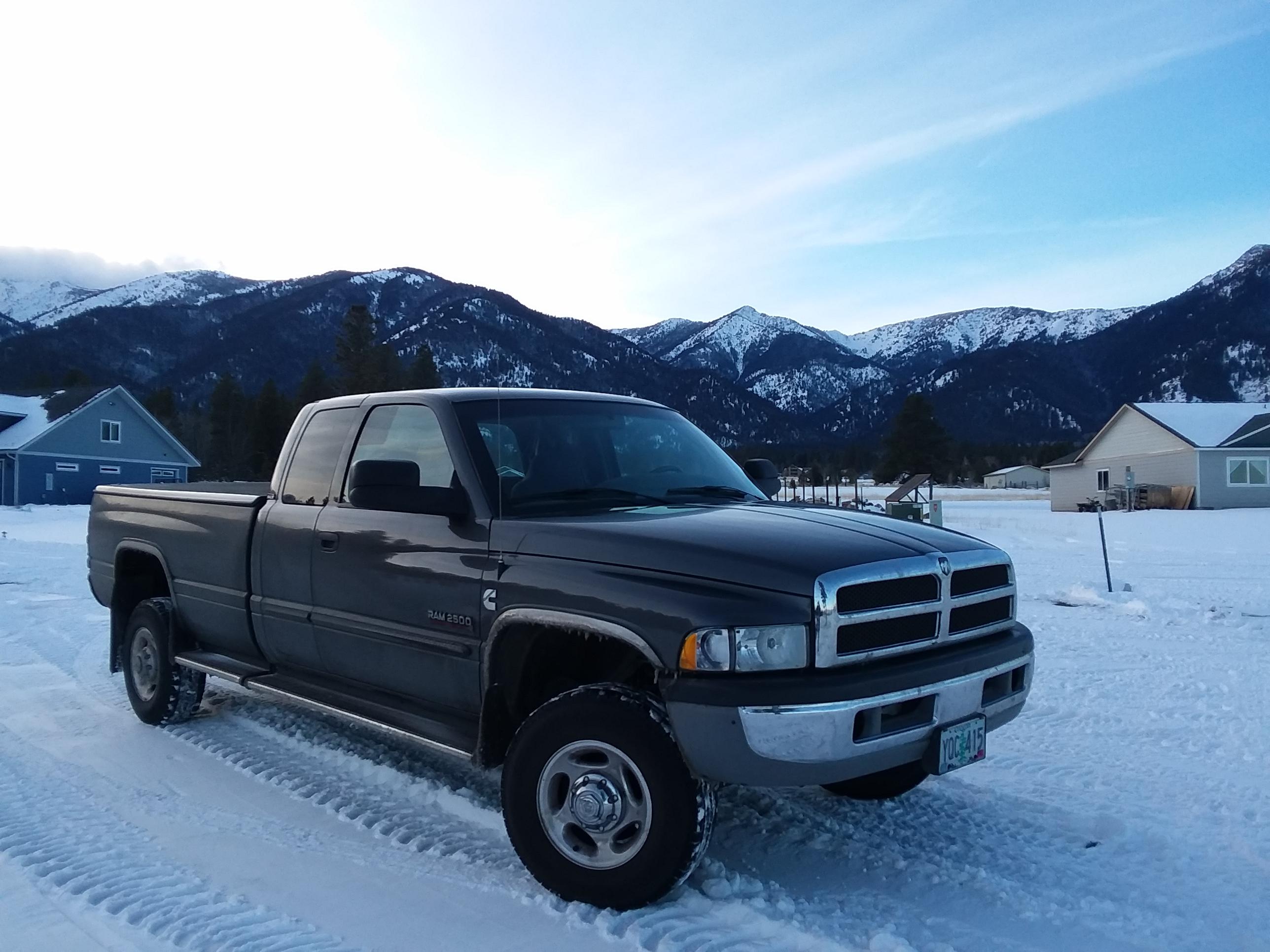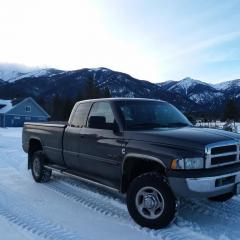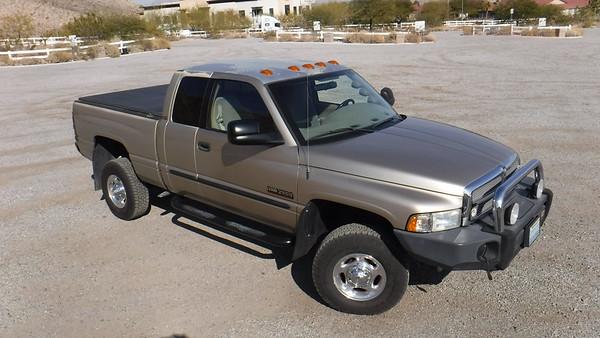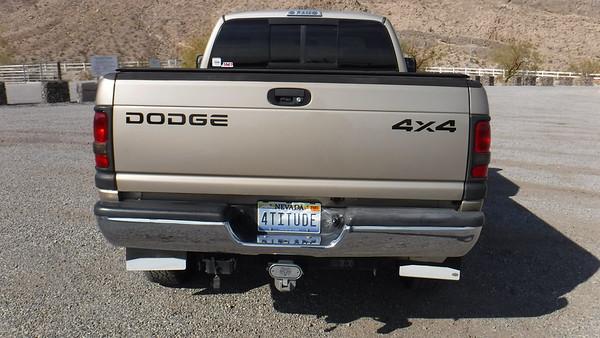
Tractorman
Yearly Subscription
-
Joined
-
Last visited
-
Currently
Viewing Forums Index
Everything posted by Tractorman
-
Alternator late to kick in, harder starts
I agree, and that is my method. I have jump started many vehicles in this manner. I still have the original Bosch alternator (brushes and bearings at 215,000 miles) with 303,000 miles on the alternator now. - John
-
Alternator late to kick in, harder starts
Some things that your video doesn't show... * You say "some hesitation starting" - does that mean the starter is cranking slowly?, or is it cranking at normal speed and just takes longer for the engine to start? (Starting the video before you turned the key would help us diagnose.) * Are you operating the throttle or is the engine going to high idle on its own? * What is the ambient air temperature? Is this a cold start? - as in the first start of the day? I am going to assume some things here. It was the first start of the day. You waited to start the engine until the "Wait to Start" light went out. The starter cranked for a longer than normal period of time. When the engine started either you brought the engine rpm up and held it there or the high idle feature was enabled. (Thanks KATOOM for this information) So, if this was your procedure, I would say that the alternator was charging normally throughout the duration of the video. The grid heaters would have drawn 200 amps while waiting for the "Wait to Start" light to go out. The starter would have drawn about 400 amps while cranking. After the engine started the post cycling of the grid heaters would have begun - again drawing 200 amps continuously because of the high idle. The alternator puts out 136 amps maximum - much less than the 200 amp draw from the grid heaters. The battery voltage falls to around 12 volts and remains there ( as it should) because the alternator that really is charging just can't keep up. The grid heaters draw whatever current is available from the alternator (which is not enough) and draw the remaining current from the batteries which drops the voltmeter down to around 12 volts and holds there.. I noticed in your video that when you said the alternator just kicked in, it appeared that the engine had dropped to an idle and the grid heaters had cycled off just a moment before. That would explain the rise to 14 volts in the voltmeter. If the starter is cranking slowly, then I would be looking at batteries that are in poor condition, corroded or loose wiring connections, worn starter contacts, etc. - John
-
He351ve stand alone Arduino controller code for 2nd Gen Cummins
Only the people near sea level elevation have the rounded figure of 14 psi. Where you are in Colorado Springs, the atmospheric pressure is about 11.8 psi. Just being technical. - John
-
Lift Pump Cutting Out
I think the "0" pump pressure and "lost power and started smoking" symptoms are likely to be from the same problem since they occurred at the same time. If the fuel flow to the VP-44 is restricted for whatever reason, it could cause the "bluish" smoke. - John
-
Steering Linkage Y, T, ?
You only need to turn the steering wheel back and forth enough to load the steering linkage (no more than 30 degrees each way). The friction of the tire to the ground helps to load the linkage. This way you can use your wife's cookie sheets for other things. - John
-
Steering Linkage Y, T, ?
You will get better "real life" test results if you set the vehicle back onto ground for the tie rod end, center link, drag link, and track bar checks because the joints will have to do some actual work. I block the rear wheels, set the park brake, and have someone operate the steering wheel back and forth with the engine running while I perform the inspection. I like your method for checking suspension ball joints and wheel bearings. - John -
-
Steering Linkage Y, T, ?
Still have the "Y" style myself - just over 300,000 miles still on original left and right tie rod ends, have replaced center link and drag link once. Of course I am using those ridiculously small tires recommended by Mopar1973Man and the goofy sticker on my driver's door. - John The above post was an attempt at humor. - John
-
Throttle acting up
Set the voltmeter to display AC millivolts (not DC) - John
-
1999 Cummins 2nd Gen Electrical short
Stick with your previous procedure. As IBMobile says, Fuse #10 (50 amp) goes to the part of the ignition switch that gives power to the BLk/WHT wire that you were testing. Test it again with Fuse #10 pulled. Post your results. One step at a time... - John
-
1999 Cummins 2nd Gen Electrical short
I have made assumptions on what you are testing, what tool you are testing with, how you are connecting with the testing tool, and the state of the connection with the ignition switch. I have made these assumptions (correctly or incorrectly) because you did not state the details. Here are my assumptions about your test: * You are using a multi-meter displaying voltage. * You are testing the output of the ignition switch, specifically the black wire with the white tracer and the light blue wire shown in the wiring diagram provided by Mopar1973Man. * You are performing your test with the wiring harness connected to the ignition switch (normal condition). * The ignition switch is in the off position. * Your multi-meter black test lead is connected to a known good ground * You are probing the BLK/WHT wire with the red test lead and you are recording 11 volts. * You are probing the LGTBLU wire with the red test lead and you are recording 10.7 volts. If this is how you are doing your ignition switch test, then your recordings may not be conclusive because the multi-meter does not place a load on the circuit - you could be reading stray voltage, or a back feeding voltage. By simultaneously connecting a test light at the same connections as your multi-meter, you can place a small electrical load on the circuit, thus eliminating any stray voltage. * If the test lamp does not light and the voltage drops to zero, then the ignition switch is not likely the problem. * If the test lamp does light and the voltage remains the same or near the same, then the ignition could be the problem, OR, another circuit could be back feeding. - John
-
1999 Cummins 2nd Gen Electrical short
Not necessarily - for a couple of reasons.. For clarification, I am assuming that you are performing the ignition switch tests with the wiring harness connected to the ignition switch. A multi-meter does not load the circuit when performing a voltage test. Consequently, stray voltage can influence the test results. Using a test lamp simultaneously with the multi-meter will be beneficial here. If the test lamp does not light and the voltage drops to zero, then the ignition switch is not likely the problem. If the test lamp does light and the voltage remains the same or near the same, then the ignition could be the problem, OR, another circuit could be back feeding. Electrical troubleshooting can be a challenge. You need to be diligent in following specific steps and always double check your work along the way. - John
-
1999 Cummins 2nd Gen Electrical short
First, let's make sure are talking about the same fuse locations. My FSM is for a 2002 truck, so fuse locations could be different than yours. Is your PDC (Power Distribution Center with fuses and relays) under the hood beside the left battery? Is the Junction Block (another fuse distribution center) on the left side of your dash with a removable cover and only visible when the driver's door is open? If both of these are true, then we have the same setup for the most part. Next question, is fuse #12 (IOD) in the Junction Block? If so, look at the wiring diagram below to count how many components are powered by this fuse - you will see plenty. You could have something as simple as a glove box light staying on and you would never know it. Looking at the diagram below shows that there are several electronic devices or switches that operate lights downstream of Fuse 12 (IOD). This is why your test light is bright when the fuse is in place. The test light is a fixed load with a specific amount of resistance. The test light by itself does not tell you how much current is flowing (amps). This is why the multi-meter with a 10 amp current testing capability is needed and is used in conjunction with the test light. One thing you can do is make sure that things like the dome light, vanity light, glove box light, under hood light, etc. are off. Here again, using the test light alone can be misleading. Because the test light bulb limits current flow, things can buzz and do strange things because the current flow is restricted by the test light bulb itself. Example: a relay coil can't get enough current flow so the contacts open and close rapidly causing a buzzing sound. Also, Fuse 13 powers the Central Timer Module. Hope this helps, - John
-
Wife thinks I need a new truck
Here's the description in case you didn't open the document. The guy lives in Las Vegas. - John $17,500 as delivered 2002 Dodge Ram 2500 HO purchaced new 12/15/2001 Quad Cab 139" wheel base VIN# 3B7KF23C92M224456 High Output motor (ETH) NV 5600 manual transmission (DEE) factory towing package - class IV receiver hitch exterior - almond light metalic pearlcoat, interior - camel/tan cloth condition 137350 miles as of Nov/03/2018 Complete mileage, service, alteration records, factory service manual no rust, no dents, paint is sun worn engine and drivetrain Southbend ConOFe Clutch BD Short Shifter Bob V's Deluxe 2-Wheel Low Kit Exhaust Brake (Jacobs) - switch on shifter 4" Magnaflow Exhaust F1 Mach 1.6 85HP injectors (stock HO injectors included) Fuel Preporator - Air Dog ISSPRO pillar-mounts gauges - fuel pressure, boost, exhaust temp Amsoil oil bypass kit new Blue Chip Diesel VP44 - premium pump x17 (5/5/2018) silicon air and water hoses new (reman) ECU (8/17/2018) new clutch hydraulics (master/slave cylinders, reservior, and lines) (11/3/2018) relocated crank case breather steering and handling Tires - (5) Goodyear Wrangler Trail Runner LT265/75R16E (3/10/2017) lower ball joints replaced (04/12/2017) replaced headliner and visors in 2016 Borgeson steering box Borgeson steering shaft Rock Solid Steering Bushing replaced tie rods and drag link with T-style heavy duty and steering dampner G3 trackbar kt (DSS) DSS (Darin's Steering Stabilizer) Maxx Link heavy duty swaybar links front & rear Bilstein Shocks accessories 50-gal in-bed TransferFlow Fuel tank w/TRAXII controller ARB Sahara Bull Bar IPF lights with "high-beam" floor switch and indicator light on pillar Viair Air compressor and tank with in-cab gauge and pressure switch Air horns (22 & 24-inch) - switch on shifter Mag-Hytec rear diff cover Jordan Brake Controller Painless Wiring Kits #70207 (2) (all electrical accessories are fused & relayed) Smittybuilt Wheel-to-Wheel step bars (with spare step pads) drivers side bed step, front and rear bumper steps Noise Reduction - triple sprayed cab and hood Alpha-Liner bed lining Swing-away storage box in bed tailgate pop-a-lock Truxedo tonneau cover Mud Flaps 2 under-seat locking boxes Dashmat dash cover (since new) extras MAD's Smarty ECM is currently stock and the MADs unit should not be VIN-locked 5th-wheel tail gate, Handy, steel, black (not installed) BHAF Heat Shield (not installed) BHAF - Fleetguard AH19037 (not installed)
-
Wife thinks I need a new truck
This one was just posted in the TDR a few days ago. It was very tempting to purchase. The guy wants $17,500 - one owner, 137,350 miles as of Nov/03/2018 - John 11-17-2018 2002 Dodge Cummins.docx
-
1999 Cummins 2nd Gen Electrical short
Good job selecting the circuits to test. You were very detail oriented in performing the above tests; however, the test results have no value. You need to know how much current each circuit is drawing. This is the test that you want to perform. Many of the circuits that you tested have parasitic draws which are normal due to some electronic components needing to have power to them at all times for memory. These circuits should stabilize and go into sleep mode a few minutes after the truck is shut down. The maximum current at that point for all combined circuits should be very low - 35 milliamps (.035 amps) for my truck according to FSM. Most likely you will have something drawing at least 500 milliamps or more in one of the circuits. You will need a test light and multi-meter. Your multi-meter should have a 10 amp setting for doing a current draw test. You will want to disable anything on your truck that could draw excessive or unwanted amperage - for example be sure to disable the driver's door switch so you won't activate the interior light circuit when you open the door. * Remove all the fuses that you did in your first test. * Disconnect ground cables from both batteries. * Temporarily secure one end of the test light to the negative battery post and the other end to the ground cable. You can use either battery location. The test light should not illuminate or if it does, it should be very dim. If it is bright, keep pulling fuses or eliminate the source of the electrical load until the light goes out or gets very dim. * Set your multi-meter to the proper setting and connect the multi-meter in the same manner as test light, but with the positive lead on the negative battery cable. Remove one end of test light to force any current to flow through the multi-meter. Observe the multi-meter display. It should read zero or very near zero milliamps. * Reconnect test light and disconnect the multi-meter. Insert one of the removed fuses. Observe that the test light remains unlit or very dim. Repeat above test with multi-meter. Continue testing until all remaining fuses are installed. Record the findings in milliamps of each individual test and add them all up. The total should be less than 35 milliamps. In reality if the total is less than 50 milliamps there should not be a problem. 50 milliamps is only 1/20th of an amp. Be sure the test light is always connected and the multi-meter is disconnected as described when you install a fuse. This will avoid a surge of current (such as charging a capacitor) to pass through the multi-meter. You will have to be careful with the multi-meter during testing as it is very easy to blow the internal 10 amp fuse. I wish you luck, - John
-
New Tire Size found 235's to 245's
Interesting. I am running stock injectors (for 303,000 miles), no two stroke oil (but 5% bio-diesel mandated in Oregon), and a Smarty SO3 on SW# 5 as well. I am just getting ready to install new RV275 injectors and I am very curious as to how well they will perform. I hope to do as well as your setup. - John
-
New Tire Size found 235's to 245's
I wait until it snows to do my burnouts. That way I can make my truck last longer. - John
-
New Tire Size found 235's to 245's
I just did a round trip from Salem, OR to Medford, OR and back (500 miles) with the 245's to pick up an excavator bucket. No mpg reduction - 20.2 mpg at 65 - 73 mph. Got slowed to 45 mph up steep grades a couple of times in southern Oregon - stayed in 6th gear and accelerated quickly back up to 65 mph. I'll never go back to the 265's. - John
-
Let's talk about shocks.
I have 73,000 miles on four Bilstein 4600 shocks and they are still working vey well today. - John
-
6 Speed manual transmission ~ NV5600 ~ General Questions
If the operator shifts the transmission into neutral and takes his foot off of the clutch pedal (as he should) when he brings the truck to a stop, then the transmission input shaft and all the gears and bearings on the counter shaft would still be turning, albeit everything would be turning at a much slower speed and there would be no load on the gears and bearings. However, there still would be plenty of splashing going on so I would think that the oil level would be quite a bit lower than it would be if the engine was shut down. Since friction from loaded bearings and gears would generate heat, it stands to reason that heat would be conducted to the oil as the oil flows around the bearings and gears. So it seems to me that you would want that sensor immersed in the oil that is returning and collecting in the lower part of the transmission. I think it would be worth some trial runs with the sensor in different locations. Just my two cents. I agree. For example, if you had been pulling a load at highway speeds for awhile and then you decided to stop and get some fuel, by the time you arrived at the service station, the transmission would have cooled considerably because of the greatly reduced load. - John
-
Floor jack recommendation
The new jacks are junk. I use old jacks because they are cheap and safer. It will mess up your grill the first time you use it, but it only happens once. They just don't make cars and trucks like they use to. What is more important is safe blocking. Jack stands are junk. Wood is cheaper. - John
-
Nv4500 always hard to shift?
Sometimes, when the transmission input shaft comes to a stop, two teeth are lined up and contacting each other head on making it hard to shift into gear - that is normal. If a pilot bearing is dragging, it will be hard to get into gear every time. Double clutching allows you to use the throttle to control engine rpm's while passing through neutral to better match engine speed to road speed, as well. Good to hear that the clutch and transmission are working okay. - John
-
Nv4500 always hard to shift?
So lots of new parts went into the transmission. You didn't specifically answer my question regarding shifting into gear from neutral at idle. Assuming that it shifts into gear easily and the only problem you really have is difficulty in shifting, try driving it for awhile in the manner I suggested in my earlier post. You may find the transmission gets easier to shift as the miles roll by. - John
-
Nv4500 always hard to shift?
What bushing are you referring to? With the engine at idle (cold or warm) with clutch engaged in neutral (foot off pedal), can you depress the clutch pedal, pause for a couple of seconds, and then easily select a gear from neutral repeatedly? If the answer is yes, then the pilot bearing is not likely causing any problems. A rebuilt transmission can feel notchy for awhile depending on how involved the rebuild was. A notchy shifter combined with a dual disc clutch will affect your shift timing, especially when upshifting. The transmission synchro is not designed to handle mismatched road to engine speed during a shift with the added weight of a dual disc clutch setup, hence "you kinda feel the teeth in third sometimes". If you decide to drive the truck as is for awhile, be deliberate in your shifting method and match engine speed to road speed for the selected gear when upshifting or downshifting. - John
-
Running Cool
It might be worth the time to inspect the new thermostat without removing it. If that rubber has separated, then coolant would be bypassing the thermostat at a low rate and it could match your symptoms. If the seal looks good, then remove the thermostat and check if any debris is lodged in the operating part of the thermostat. Sometimes it takes awhile for debris to settle after a radiator flush because you can't get all of the debris out. - John










